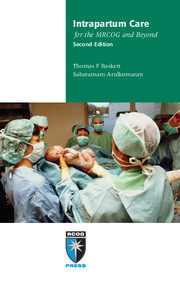Book contents
- Frontmatter
- Contents
- Preface
- Abbreviations
- 1 Improving intrapartum care
- 2 First stage of labour
- 3 Second stage of labour
- 4 Fetal surveillance in labour
- 5 Third stage of labour
- 6 Lower genital tract trauma
- 7 Induction of labour
- 8 Preterm labour and prelabour rupture of membranes
- 9 Assisted vaginal delivery
- 10 Shoulder dystocia
- 11 Breech vaginal delivery
- 12 Twin and triplet delivery
- 13 Caesarean section
- 14 Vaginal birth after caesarean section
- 15 Uterine rupture
- 16 Emergency obstetric hysterectomy
- 17 Cord prolapse
- 18 Antepartum haemorrhage
- 19 Postpartum haemorrhage
- 20 Acute uterine inversion
- 21 Amniotic fluid embolism
- 22 Disseminated intravascular coagulation
- 23 Acute tocolysis
- 24 Severe pre-eclampsia and eclampsia
- 25 Neonatal resuscitation
- 26 Perinatal loss: management of late fetal death and stillbirth
- Index
16 - Emergency obstetric hysterectomy
Published online by Cambridge University Press: 05 July 2014
- Frontmatter
- Contents
- Preface
- Abbreviations
- 1 Improving intrapartum care
- 2 First stage of labour
- 3 Second stage of labour
- 4 Fetal surveillance in labour
- 5 Third stage of labour
- 6 Lower genital tract trauma
- 7 Induction of labour
- 8 Preterm labour and prelabour rupture of membranes
- 9 Assisted vaginal delivery
- 10 Shoulder dystocia
- 11 Breech vaginal delivery
- 12 Twin and triplet delivery
- 13 Caesarean section
- 14 Vaginal birth after caesarean section
- 15 Uterine rupture
- 16 Emergency obstetric hysterectomy
- 17 Cord prolapse
- 18 Antepartum haemorrhage
- 19 Postpartum haemorrhage
- 20 Acute uterine inversion
- 21 Amniotic fluid embolism
- 22 Disseminated intravascular coagulation
- 23 Acute tocolysis
- 24 Severe pre-eclampsia and eclampsia
- 25 Neonatal resuscitation
- 26 Perinatal loss: management of late fetal death and stillbirth
- Index
Summary
Emergency postpartum hysterectomy is one of the most commonly accepted markers of severe maternal morbidity. The incidence varies from about 1/350 to 1/7000 deliveries and the maternal mortality rate ranges from 0% to 35%. The higher incidence and mortality rates are found in regions with limited hospital resources. In developed countries the incidence of emergency obstetric hysterectomy is about 1/2000– 3000. There is an association between emergency hysterectomy and caesarean section and between emergency hysterectomy and multiple pregnancy. With increasing rates of caesarean delivery and with assisted reproductive techniques producing more multiple pregnancies, the need for obstetric hysterectomy is increasing in some countries. For example, in Canada between 1991 and 2003 the obstetric hysterectomy rate rose significantly from 0.26/1000 deliveries to 0.46/1000 deliveries.
Indications
The three main conditions leading to obstetric hysterectomy are abnormal placentation, uterine atony and uterine rupture and trauma.
ABNORMAL PLACENTATION: PLACENTA PRAEVIA AND/OR ACCRETA
The rising incidence of delivery by caesarean section has been accompanied by an increased risk of placenta praevia and/or accreta in subsequent pregnancies, making these the most common reasons for obstetric hysterectomy in developed countries.
- Type
- Chapter
- Information
- Intrapartum Care for the MRCOG and Beyond , pp. 181 - 188Publisher: Cambridge University PressPrint publication year: 2011



